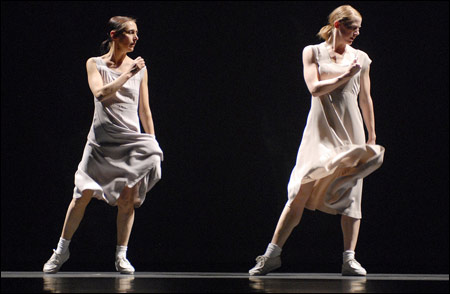NEW YORK — Lots of people have choreographed Steve Reich’s music. During his decades-long inquiry into speech, harmony, and electronics, his meditations on religious and social themes, his reconfiguring of the concert orchestra, and his challenges to individual musicianship, Reich has never abandoned rhythm. All his music, from the simplest to the most complex, has an underlying, unifying pulse that entices the body into movement. His major sources of influence — jazz, West African drumming, and Balinese gamelan — also depend on a galvanizing pulse and draw little distinction between musicmaking and dancing. As a dancer noted when introducing Akram Khan’s new Variations for Vibes, Pianos and Strings last week at the Brooklyn Academy of Music’s Next Wave Festival, “We’re working in the place where the music and the dance are one.”

FASE: Moving in exact unison but not alike at all.
|
Commissioned in 2005 for Khan and the London Sinfonietta, the Variations had its US premiere at BAM on October 3, kicking off a month-long 70th-birthday celebration for Reich that will spread to other big culture palaces of New York City. Khan follows an impressive line of choreographers who’ve been seduced by Reich’s music. The BAM concert began with a middle-generation Reichian, Anne Teresa De Keersmaeker, who revived her 1982 piece Fase. De Keersmaeker and Khan are as far apart stylistically as Reich’s new composition is from the austerities of Clapping Music. It’s a sign of Reich’s potency that contemporary dancers find him as compelling now as the dance avant-garde did 35 years ago. For me the whole evening was a trip — like flying across the Pacific through 14 time zones.
Curiously missing on stage, and in all the accompanying celebratory verbiage, was any reference to Reich’s first dance collaborator, Laura Dean. For five years or so at the beginning of the ’70s, Dean’s spinning-stepping dances and Reich’s rhythm patterns exemplified downtown minimalism at its most extreme and invigorating. (No, it never put me to sleep, just the opposite.) As dictated by the counterculture, symphonic form, dance technique, emotionality, and the star system were out the window. You did simple steps, four-note motifs, lots and lots of repetition so the audience could appreciate shifting accents and directions. Dean and Reich would be tracing basic geometric layouts, counting into the hundreds before anything changed, repeating bone-dry elements till they flowed like a waterfall.
Their collaboration culminated in the big ensemble piece Drumming (produced by BAM in 1975). Dean was already incorporating balletic steps, leaps, and fancy gestures. After Drumming she began to write and play her own musical accompaniments. Reich developed large-scale formats and continued to pursue the basics of rhythm with counterpoint pieces where one performer played against pre-recorded tracks of himself. Since the monastic early days, Reich scores have served Elisa Monte’s eroticism in Treading (1981), Lar Lubovitch’s sensuous journey in Cavalcade (1996), and Twyla Tharp’s balletic/soft-shoe marathon in the last part of Known by Heart (1998).
ADVERTISEMENT
 |
But Anne Teresa De Keersmaker was the first dancer who I thought embraced both the structural intensity and the implicit expressivity of Reich, when she performed Violin Phase in a 1981 solo concert at Dance Theater Workshop. A graduate student in dance at NYU, she soon returned to her native Belgium to start the dance company Rosas. She’s choreographed other Reich works since then, as well as some more theatrical, feminist pieces, and her company is now in residence at the Théâtre de la Monnaie in Brusssels.
Fase incorporates Violin Phase and Come Out from De Keersmaeker’s New York period, the pair bracketed by Piano Phase and Clapping Music, all pieces composed between 1966 and ’72. De Keersmaeker’s performance in ’81 came at a time when the rigors of minimalism were giving way to more relaxed and conventionally virtuosic styles of dancing. Seeing Fase now was a shock. The audience held its breath for 25 minutes, then burst into applause after Piano Phase, in which two women did little more than step forward and back, then pivot 180 degrees while swinging one arm straight out. They elaborated a little on this, mainly to change the timing of the basic phrase pattern, but also to add a few flourishes — a hitch step, a quarter-turn, an arm whipping around the waist.
Reich built his piece the same way, with a repeating four-note motif that varies only when a second piano gradually increases its tempo until the two lines are back in synch, now creating a different rhythmic pattern. This is Reich’s famous “phasing,” a term he borrowed from physics or something. I seem to remember a primal piece of his that consisted of two swinging pendulums.
You can execute phase patterns easily on a synthesizer, but phasing by two live musicians is hard. Even Reich relinquished it for Clapping Music, instead establishing definite cues with his partner so that one of them would simply jump the pattern one beat ahead. Until Fase I’d never seen dancers who could actually accomplish phasing. Anne Teresa De Keersmaeker sped up her walk-pivot-swing gradually through four or five rounds while Tale Dolven kept the original tempo. It’s amazing to see this in-and-out-of-synch effect recurring through the dance.